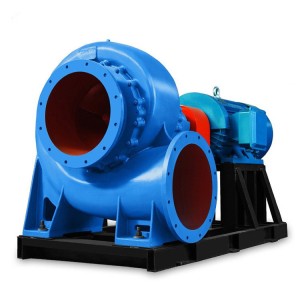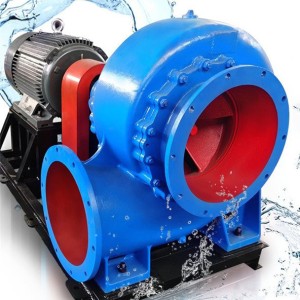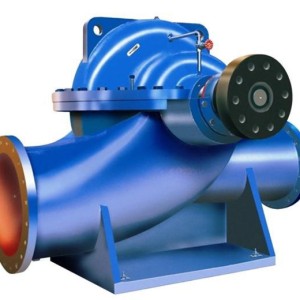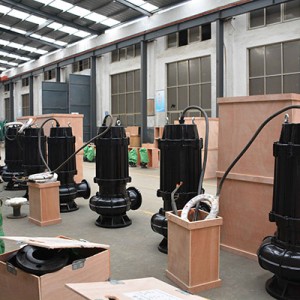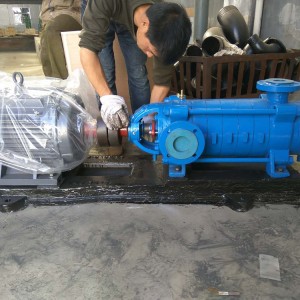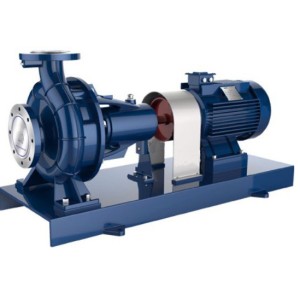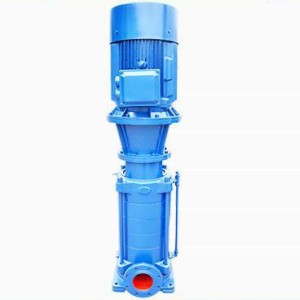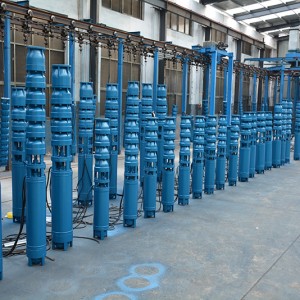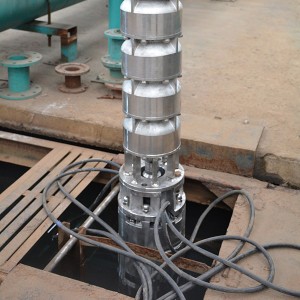First. The basic structure of the vertical pipeline centrifugal pump is composed of six parts. The basic structure of the vertical pipeline centrifugal pump is composed of six parts, namely the impeller, pump body, pump shaft, bearing, sealing ring, and stuffing box.
1. The impeller is the core part of the centrifugal pump. It has a high speed and a large output. The blades on the impeller play a major role. The impeller must pass a static balance experiment before assembly. The inner and outer surfaces of the impeller are required to be smooth to reduce the friction loss of the water flow.
2. The pump body is also called the pump casing, which is the main body of the water pump. Play a supporting and fixing role, and connect with the bracket for mounting the bearing.
3. The function of the pump shaft is to connect the motor with the coupling to transmit the torque of the motor to the impeller, so it is the main part of the transmission of mechanical energy.
4. The bearing is a component that is sleeved on the pump shaft to support the pump shaft. There are two types of rolling bearings and sliding bearings. Rolling bearings use tallow as a lubricant and refuel appropriately. Generally 2/3~3/4 of the volume is too much to generate heat, too little and there is noise and heat! Sliding bearings use transparent oil as lubricant, add oil to the oil level String. Too much oil will seep out along the pump shaft and drift low, too little bearing will overheat and burn out and cause accidents! During the operation of the water pump, the bearing temperature will be as high as 85 degrees and generally run at about 60 degrees. If it is high, find the cause. (Whether there are impurities, whether the oil is black, and whether water has entered) and deal with it in time!
5. The sealing ring is also called the leakage reducing ring. The gap between the impeller inlet and the pump casing is too large to cause the water in the high-pressure area of the pump to flow to the low-pressure area through this gap, which affects the pump’s water output and reduces efficiency! Too small a gap will cause friction and wear between the impeller and the pump casing. In order to increase the return resistance, reduce internal leakage, and delay the service life of the impeller and the pump casing, a sealing ring is installed at the junction of the inner edge of the pump casing and the external aid of the impeller, and the sealing gap should be kept between 0.25 and 1.10mm.
6. The stuffing box is mainly composed of packing, water seal ring, packing tube, packing gland and water seal pipe. The function of the stuffing box is mainly to close the gap between the pump casing and the pump shaft, so that the water in the pump does not flow to the outside and the outside air does not enter the pump. Always maintain the vacuum in the pump! When the pump shaft and the packing friction generate heat, the water seal pipes the water to the water seal ring to cool the packing! Keep the pump running normally. Therefore, special attention should be paid to the inspection of the stuffing box during the running inspection of the pump! The stuffing should be replaced after 600 hours of operation.
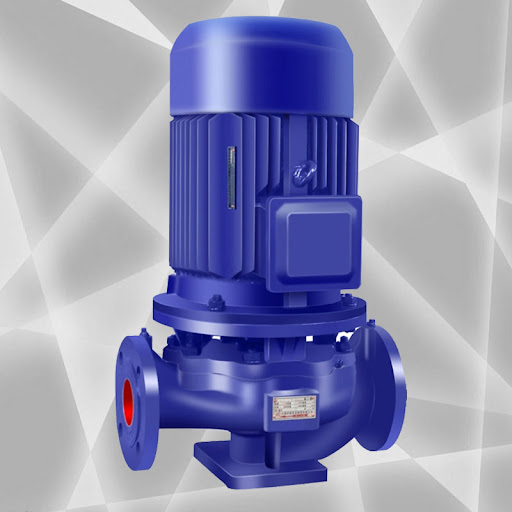
Second, the flow parts of the centrifugal pump
The flow-through components of the centrifugal pump include three parts: suction chamber, impeller, and press-out chamber. The impeller chamber is the core of the pump and also the core of the flow component. The pump works on the liquid through the impeller to increase its energy.
The impeller is divided into three categories according to the direction of the liquid outflow:
(1) Radial flow impeller (centrifugal impeller) liquid flows out of the impeller in a direction perpendicular to the axis.
(2) Diagonal flow impeller (mixed flow impeller) The liquid flows out of the impeller along the inclined direction of the axis.
(3) The direction of liquid flow in the axial flow impeller is parallel to the axis.
The impeller is divided into two categories according to the way of inhalation:
(1) Single suction impeller (that is, the impeller sucks liquid from one side).
(2) Double suction impeller (that is, the impeller sucks liquid from both sides).
The impeller is divided into three categories according to the cover plate:
(1) Enclosed impeller.
(2) Open impeller.
(3) Semi-open impeller.
The enclosed impeller is widely used, and the aforementioned single-suction impeller and double-suction impeller all belong to this form.
Three, the working principle of centrifugal pump
The working principle of the centrifugal pump is: the centrifugal pump can send water out because of the centrifugal force. Before the pump works, the pump body and the water inlet pipe must be filled with water to form a vacuum state. When the impeller rotates quickly, the blades prompt the water to rotate quickly, and the rotating water flies away from the impeller under the action of centrifugal force. The water in the pump After being thrown out, the central part of the impeller forms a vacuum area. The water in the water source is pressed into the inlet pipe through the pipe network under the action of atmospheric pressure (or water pressure). In this way, the circulation is endless and continuous pumping can be realized. It is worth mentioning here that the centrifugal pump must be filled with water in the pump casing before starting, otherwise it will cause the pump body to heat up, vibrate, reduce the water output, and cause damage to the pump (referred to as “cavitation”) Cause an equipment accident!
There are many types of centrifugal pumps, and the common classification methods are as follows
1 According to the impeller suction method: single-suction centrifugal pump, double-suction centrifugal pump. 2 According to the number of impellers: single-stage centrifugal pump, multi-stage centrifugal pump. 3 According to the impeller structure: open impeller centrifugal pump, semi-open impeller centrifugal pump, closed impeller centrifugal pump. 4 According to working pressure: low pressure centrifugal pump, medium pressure centrifugal pump, high pressure centrifugal pump, vertical centrifugal pump.
Fourth, the following introduces several important performance curves of centrifugal pumps.
There is a certain relationship between the performance parameters of the pump, such as flow Q, head H, shaft power N, speed n, and efficiency η. The relationship between the value changes between them is represented by a curve, and this curve is called the performance curve of the pump. The mutual change relationship and mutual restriction between the performance parameters of the water pump: First of all, the forehead speed of the water pump is a prerequisite.
The pump performance curve has three main curves: flow-head curve, flow-power curve, flow-efficiency curve.
A. Flow-head characteristic curve It is the basic performance curve of a centrifugal pump. The centrifugal pump with a specific speed of less than 80 has the characteristics of rising and falling (both convex in the middle and downward bending on both sides), which is called the hump performance curve. The centrifugal pump with a specific speed between 80 and 150 has a flat performance curve. Centrifugal pumps with specific revolutions above 150 have a steep drop performance curve. Generally speaking, when the flow rate is small, the head is high, and the head gradually decreases as the flow rate increases.
B. Flow-power curve The shaft power increases with the flow. When the flow Q=0, the corresponding shaft power is not equal to zero, but is a certain value (about 60% of normal operation). This power is mainly consumed by mechanical losses. At this time, the water pump is full of water. If it is operated for a long time, the temperature in the pump will continue to rise, and the pump casing and bearings will heat up. In severe cases, the pump body may be thermally deformed. We call it “stuffy head”. The head is the maximum value. When the outlet valve is gradually opened, the flow rate will gradually increase, and the shaft power will also slowly increase.
C. Flow-efficiency curve. Its curve is like a hill. When the flow is zero, the efficiency is equal to zero. With the increase of the flow, the efficiency gradually increases, but after increasing to a certain value, the efficiency drops. There is an efficiency. The highest value, near the highest efficiency point, the efficiency is relatively high, this area is called the high efficiency zone.
Shenlong Pumps sells various types of vertical pipeline centrifugal pumps, welcome to buy.
Post time: 2021-12-30


